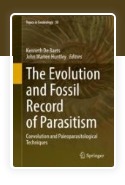“The fossil record of parasites is limited thus far. A survey of the fossil record shows that some modes of preservation show a higher potential for the preservation of parasitic remains or parasite–host associations than generally recognized. A better understanding of the taphonomy of parasites is critical to better predict their preservation potential and, together with new techniques like computed tomography, can open the door for systematic screening of parasite sources in deep time. Phosphatization seems particularly fruitful to characterize anatomical details for microscopic parasites or pathogens. Amber deposits are rich in terrestrial parasitic ecdysozoans and their pathogens, but their extent does not bracket a single mass extinction. For particular parasite–host associations, preservation of direct evidence is unlikely, but traces they leave in skeletons and other host remains can be used to trace them back to the Mesozoic or even the Paleozoic. Vertebrate coprolites have yielded remains of endoparasites as far back as the Carboniferous, but a more systematic screening of coprolites is necessary to make them a successful source of parasitic remains as for the Quaternary. Parasites with preservable hard parts and/or characteristic pathologies have the best potential to track changes in marine disease prevalence in high resolution across extinction or environmental perturbations in deep time, but more studies need to report their sample sizes and prevalences.” Interested?

